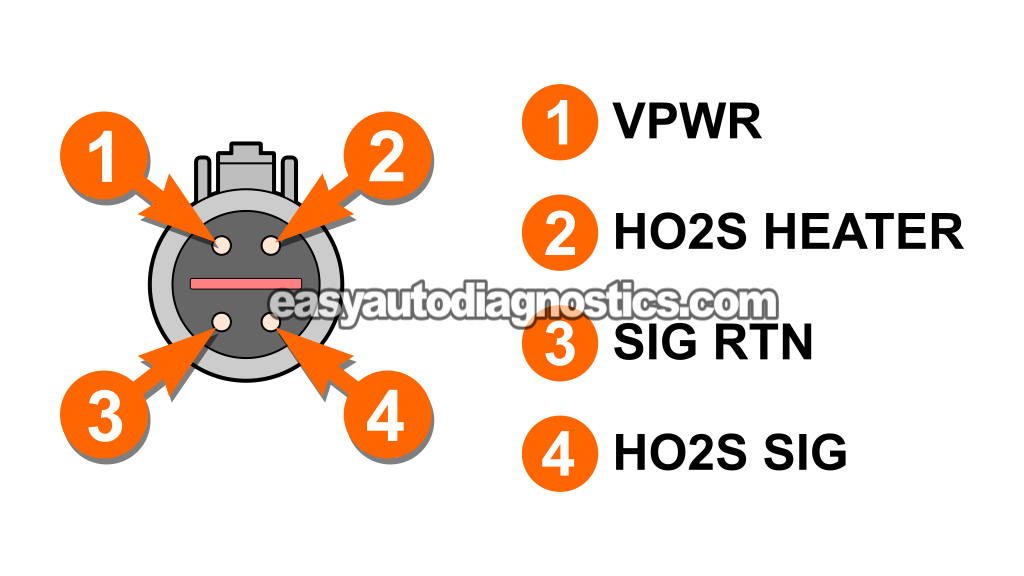
Your 2.0L Ford Escape (or 2.0L Mazda Tribute) comes equipped with 2 oxygen sensors. When the upstream oxygen sensor's internal heater fails, you're gonna' see a diagnostic trouble code P0135: HO2S 11 Circuit Malfunction lighting up the check engine light on your instrument panel.
The cool thing is that testing the upstream oxygen sensor's heater is pretty easy and in this tutorial, I'll help you test it.
In case you're wondering what tools you'll need: All you'll need is a multimeter and in 3 basic tests you can find out if it's fried or not.
NOTE: This oxygen sensor is known by several different names:
- Pre-Catalytic Converter Oxygen (O2) Sensor.
- HO2S 11 (Heated Oxygen Sensor Bank 1 Sensor 1).
- Upstream Oxygen (O2) Sensor.
- Oxygen Sensor Bank 1 Sensor 1.
Contents of this tutorial:
![]() You can find this tutorial in Spanish here: Calentador del Sensor de Oxígeno -P0135 (2001-2004 2.0L Ford Escape) (at: autotecnico-online.com).
You can find this tutorial in Spanish here: Calentador del Sensor de Oxígeno -P0135 (2001-2004 2.0L Ford Escape) (at: autotecnico-online.com).
APPLIES TO: This tutorial applies to the following vehicles:
- 2.0L Ford Escape: 2001, 2002, 2003, 2004.
- 2.0L Mazda Tribute: 2001, 2002, 2003, 2004.
P0141 CODE DIAGNOSTIC TESTS:
Circuit Descriptions Of The Upstream Oxygen Sensor

The upstream oxygen sensor (HO2S 11), on your 4 cylinder 2.0L Ford Escape (2.0L Mazda Tribute) is a 4-wire oxygen sensor.
2 wires are for the section, of the front O2 sensor, that deals with sensing the oxygen content of the engine's exhaust. The other 2 wires are the ones that feed power and Ground to the heater element.
Below, you'll find the color of the wires of the engine wiring harness oxygen sensor connector for sensor HO2S 11:
| Upstream Oxygen Sensor Pinout (2001-2004 2.0L Ford Escape) | ||
|---|---|---|
| Pin | Wire Color | Description |
| 1 | Light blue with orange stripe (LT BLU/ORG) | VPWR —Heater Power (+) |
| 2 | Red with white stripe (RED/WHT) | H2OS HEATER —Heater Ground (-) |
| 3 | Orange (ORG) | SIG RTN —O2 Signal Ground |
| 4 | Gray with light blue stripe (GRY/LT BLU) | H2OS SIG —O2 Signal |
NOTE: The O2 sensor connector (the one that belongs to the engine wiring harness) on your Ford Escape or Mazda Tribute has one large index tab and two small index tabs. The location of the small tabs may differ from the illustration shown in this tutorial. Always use the large index tab as your reference point when making your multimeter connections and tests.
Where To Buy The Oxygen Sensor And Save
If your 2.0L Ford Escape (2.0L Mazda Tribute) needs a new upstream oxygen sensor, take a look at the links below. I think they'll save you some bucks:
Disclosure: As an Amazon Associate, I earn from qualifying purchases. Buying through these links helps support this site at no extra cost to you. Thanks for your support —it really means a lot!
NOTE: If you're not sure if the above upstream O2 sensor fit your particular 2.0L Escape (2.0L Mazda Tribute) don't worry. Once you get to the site, they'll make sure the sensor is the right one, if not, they'll find you the right one.
TEST 1: Verifying The Heater Element Is Getting Power

Your 2.0L Ford Escape's upstream O2 sensor's heater element gets power (VPWR) from fuse 5 of the Battery Junction Box thru the light blue with orange stripe (LT BLU/ORG) wire of its engine wiring harness connector.
So, to get our P0135 diagnostic under way, the first thing we're gonna' do is check that this wire does have 10 to 12 Volts DC with the Key On Engine Off (KOEO).
CAUTION: Perform this test with a completely cold engine to avoid getting burned from a hot O2 sensor or exhaust manifold! Be careful and take all necessary safety precautions!
IMPORTANT: The VPWR test is done on the engine wiring harness connector which has female terminals.
NOTE: The O2 sensor connector (the one that belongs to the engine wiring harness) on your Ford Escape or Mazda Tribute has one large index tab and two small index tabs. The location of the small tabs may differ from the illustration shown in this tutorial. Always use the large index tab as your reference point when making your multimeter connections and tests.
OK, this is what you'll need to do:
- 1
Disconnect the upstream O2 sensor from its engine wiring harness connector.
- 2
Turn the key ON but don't start the engine.
- 3
Set your multimeter to Volts DC mode.
- 4
Ground the black multimeter test lead directly on the battery negative (-) terminal.
You may need to use a long jumper wire to extend the reach of your multimeter test lead. - 5
Probe female terminal 1 with the red multimeter test lead.
NOTE: Make sure that terminal 1 connects to the LT BLU/ORG wire of the connector. - 6
Your multimeter should register 10 to 12 Volts DC.
Let's take a look at your test results:
CASE 1: The LT BLU/ORG wire is delivering 10 to 12 Volts DC. That's exactly what you want to see because it tells you the heater circuit inside the upstream O2 sensor is being supplied with battery power.
The next step is to make sure that the RED/WHT wire is supplying Ground to the sensor's heater element. Go to: TEST 2: Verifying The Heater Element Is Getting Ground.
CASE 2: The LT BLU/ORG wire IS NOT delivering 10 to 12 Volts DC. Double-check you're checking the right terminal and that the key is in the RUN position and retest it to be sure.
If you still don't see battery power, the O2 sensor itself isn't the problem, since without this voltage its heater can't function.
Your next step is to check fuse 5 (at the Battery Junction Box) and see if it's blown. Once you restore power to the LT BLU/ORG wire, the front O2 sensor's heater will function again.
TEST 2: Verifying The Heater Element Is Getting Ground

For our second test, we're going to check that the upstream O2 sensor's heater element is getting Ground.
I want to point out that this Ground activates the heater element, and it's supplied by the red with white stripe (RED/WHT) wire of the engine wiring harness O2 sensor connector.
This Ground is not a chassis Ground. It's a Ground that's provided internally by your Ford Escape's PCM, and it's only available with the key in the ON position.
We'll do a simple multimeter voltage test to see if the RED/WHT wire is feeding the heater with this activation signal.
CAUTION: The heater element gets Ground from the PCM (internally). Be careful that you don't accidentally or intentionally short this wire to battery power or you'll fry your Ford's PCM. Doing the described multimeter voltage test below is a safe way to test this circuit for Ground.
NOTE: The H2OS HEATER circuit test takes place on the engine wiring harness connector (which has female terminals) and NOT on the connector that belongs to the O2 sensor itself.
These are the test steps:
- 1
Turn the key ON but don't start the engine.
- 2
Set your multimeter to Volts DC mode.
- 3
Connect the red multimeter test lead directly on the battery positive (+) terminal.
You may need to use a long jumper wire to extend the reach of your multimeter test lead. - 4
Gently probe the female terminal 2 with the black multimeter test lead.
NOTE: Confirm that terminal 2 connects to the RED/WHT wire of the connector. - 5
The multimeter should register 10 to 12 Volts DC.
Let's see what your test result is telling us:
CASE 1: The RED/WHT wire is delivering Ground. That's exactly what you want to see and it confirms the PCM is able to activate the O2 sensor's heater.
With both power and Ground verified, your next step is to check the heater element itself. Head over to: TEST 3: Testing The Heater Element's Resistance.
CASE 2: The RED/WHT wire IS NOT delivering Ground. Double-check you're checking the right terminal and that the key is in the RUN position and retest it to be sure.
If you still don't see Ground present, the O2 sensor itself isn't the problem, since without this PCM supplied Ground the heater won't activate.
The most likely cause of this missing Ground is an open-circuit problem in the RED/WHT wire between the O2 sensor connector and the PCM.
TEST 3: Testing The Heater Element's Resistance

So far, your previous tests have confirmed that:
- A P0135 trouble code is lighting up the check engine light on your 2.0L Ford Escape's instrument panel.
- The LT BLU/ORG wire has power (TEST 1).
- The RED/WHT wire has Ground (TEST 2).
For our last test, we're gonna' check the O2 sensor's heater element's resistance and see if its within 3 to 30 Ωs.
If the resistance is not within specification, then we can conclude the upstream O2 sensor is bad and the cause of the P0135: HO2S 11 Circuit Malfunction trouble code.
NOTE: Just a reminder that the upstream oxygen sensor has to be completely cold before proceeding with this test since the manual calls for the O2 sensor to be at room temperature for the resistance test.
OK, this is what you need to do:
- 1
Locate terminals 3 and 4 of the connector that connects directly to the upstream O2 sensor.
NOTE: This test is done on the connector coming out of the O2 sensor itself. This connector has round male terminals. - 2
Set your multimeter to Ohms mode.
- 3
With the multimeter test leads, probe male terminals 3 and 4 of the O2 sensor connector.
- 4
If all is OK, you should see about 3 to 30 Ωs on your multimeter.
If the heater element is fried, your multimeter will show an open (usually indicated by the letters OL) or a number over 10 K Ωs.
Let's take a look at your test results:
CASE 1: Your multimeter confirmed the indicated resistance. This is the correct and expected test result, which confirms the upstream O2 sensor's heater element is OK.
If a P0135 trouble code keeps coming back, the heater itself isn't the cause. The fault lies elsewhere in the circuit or PCM control, and that's where your troubleshooting needs to continue.
CASE 2: Your multimeter shows either an open-circuit (OL/infinite resistance) or a short-circuit (0 Ohms). That result tells you the upstream O2 sensor's (Bank 1 Sensor 1) heater element has failed.
Replace the upstream oxygen sensor (to clear the P0135 DTC) if all these three conditions are true:
- Power supply to the heater circuit is present (confirmed in TEST 1).
- Ground to the heater circuit is present (confirmed in TEST 2).
- The heater element's resistance is out of spec, as confirmed in this test section.
More 2.0L Ford Escape Diagnostic Tutorials
You can find a complete list of 2.0L Ford Escape tutorials in this index:
Here's a small sample of the tutorials you'll find in the index:
- How To Test Engine Compression (2001-2004 2.0L Ford Escape).
- How To Test The Throttle Position Sensor (2001-2004 2.0L Ford Escape).
- How To Test The Fuel Injectors (2001-2004 2.0L Ford Escape).
- How To Test The Starter Motor (2001-2004 2.0L Ford Escape).

If this info saved the day, buy me a beer!






